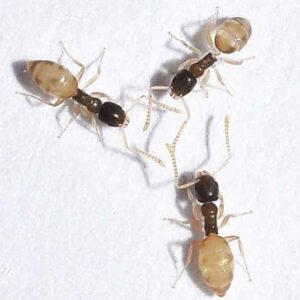
Ghost Ant

Ghost Ants: Exploring Their Habits, Anatomy, and Impact
Ghost ants, scientifically known as Tapinoma melanocephalum, may be diminutive, but their presence can loom large in homes and gardens. In this insect library, we embark on a journey to demystify the world of Ghost ants, exploring their habits, anatomy, and impact on the environments they inhabit.
Ghost ants exhibit a remarkable adaptability to diverse habitats, making them ubiquitous in both indoor and outdoor settings. These resourceful insects establish nests in soil, leaf litter, and even within the cavities of plants. Their elusive nature allows them to thrive unnoticed until their colonies expand significantly.
Ghost ants employ a reproductive strategy that ensures the silent and rapid expansion of their colonies. Queens produce new colony members through a process called budding, where satellite colonies break off from the main nest. This efficient system enables Ghost ants to establish colonies in diverse locations.
Transitioning into the dietary habits of Ghost ants, it becomes evident that these tiny creatures have a sweet tooth. They are drawn to sugary substances, fruits, and nectar. The persistent trails they create while foraging can lead them to the heart of our homes, making them unwelcome visitors in search of sustenance.
Environmental Impact & Life Cycle
The ecological impact of Ghost ant infestations extends beyond the boundaries of our homes. Their voracious appetite for honeydew-producing insects disrupts local ecosystems, affecting the delicate balance of the natural world. Understanding these consequences is crucial for devising effective pest control measures.
Ghost ants are characterized by their minute size, measuring around 1.3 to 1.5 millimeters. Their bodies are semi-transparent, giving them their ghostly appearance. This unassuming stature allows them to infiltrate our living spaces with ease, often evading detection until their numbers become apparent.
The life cycle of Ghost ants consists of four stages: egg, larva, pupa, and adult. Queens lay eggs, and workers tend to the developing brood, ensuring the continuous expansion of the colony. The ability to adapt to various environments contributes to the success of Ghost ant colonies.
Effective management of Ghost ant infestations requires a delicate balance between understanding their behavior and implementing preventive measures. Identifying and sealing entry points, regularly cleaning potential food sources, and utilizing bait traps are practical strategies to discourage their unwelcome presence.
For persistent Ghost ant problems, seeking professional help is a prudent choice. Pest control experts, armed with knowledge and proven interventions, can address infestations comprehensively. Passive voice is occasionally employed by pest control professionals when describing the process of tackling ant invasions.
Conclusion
In concluding this exploration of Ghost ants, it is clear that these tiny specters leave a substantial impact on both indoor and outdoor environments. By unraveling their habits, anatomy, and ecological consequences, homeowners can make informed decisions to mitigate the challenges posed by Ghost ant infestations. The key lies in coexistence strategies that balance effective pest control with an understanding of the role these microscopic invaders play in the intricate tapestry of our living spaces.

